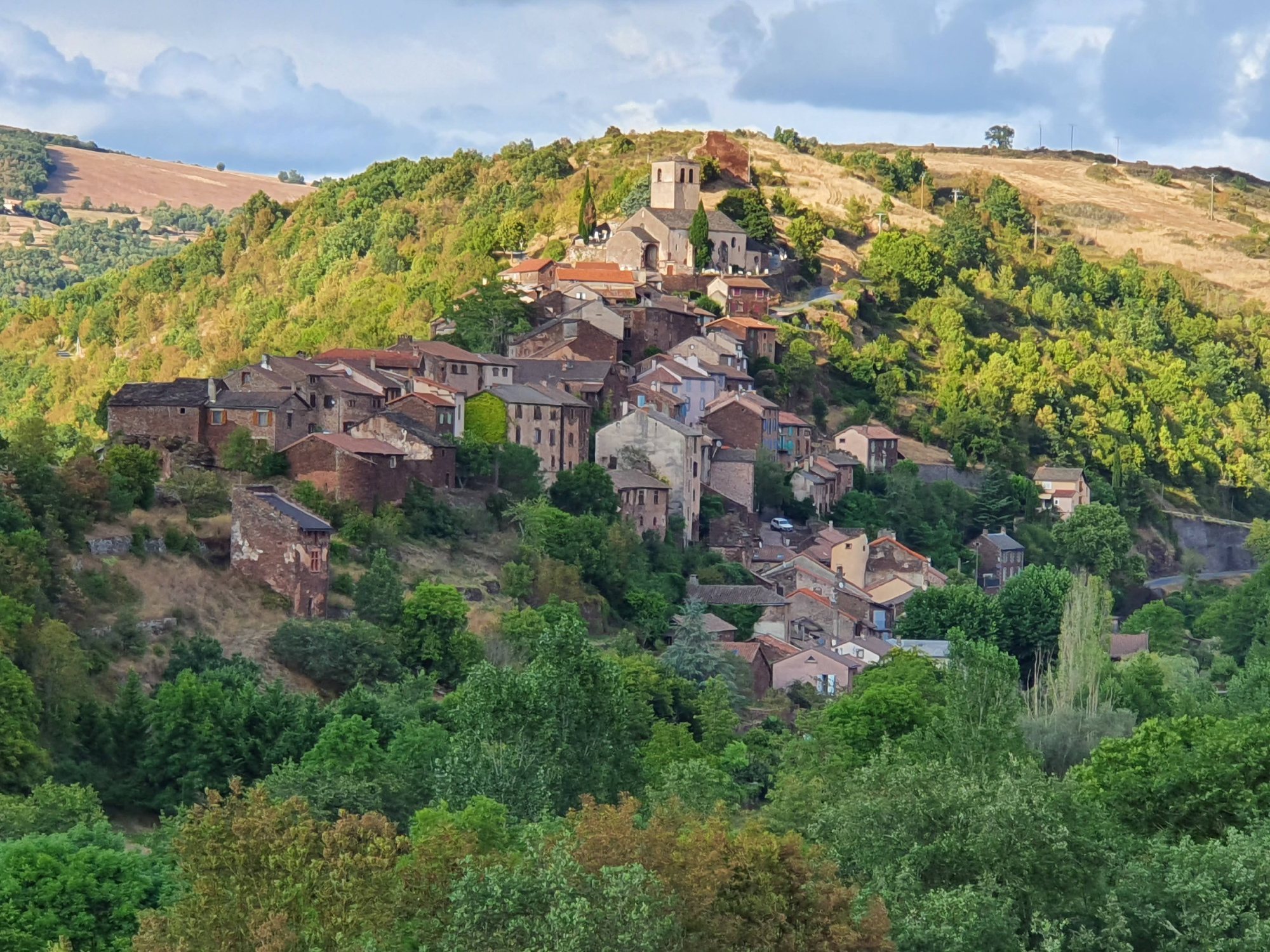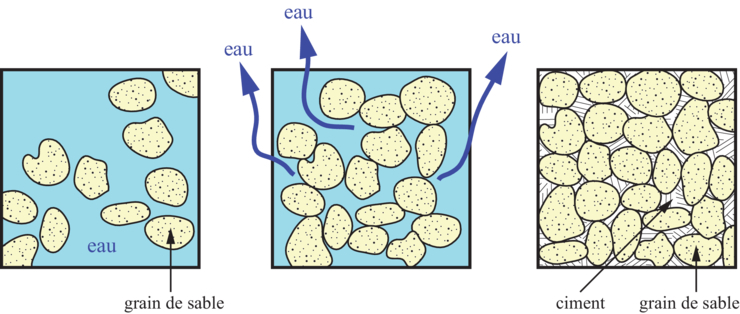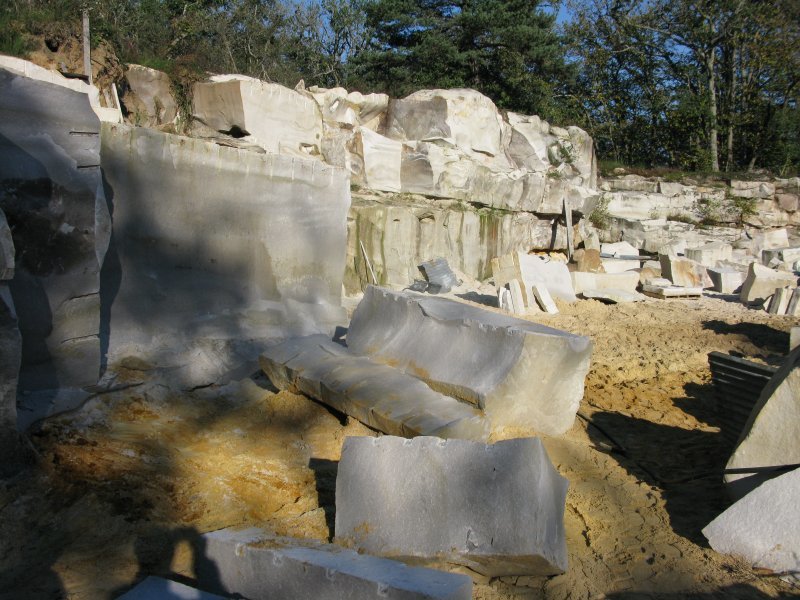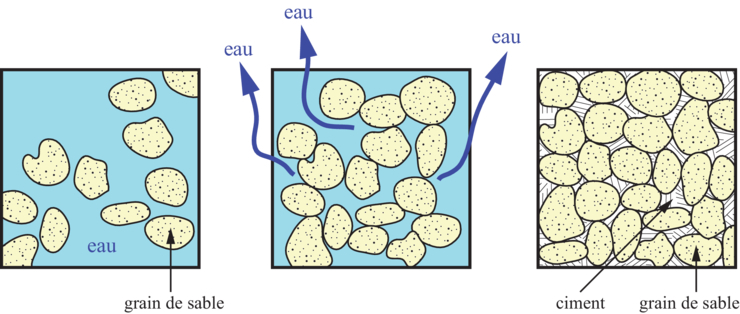 Au Grès de Combret
Au Grès de Combret 

 Version Française
Version Française
Le grès est une roche sédimentaire. Cette roche est composée de micas, de quartz et de feldspath. Les couleurs sont très variables : il y a du grès rouge, ocre, rose, vert, gris, blanc, jaune, marron, violet, doré et argenté. Le grès est utilisé pour les pierres de construction, les meules, les pavages et pour les sculptures.
C’est une roche dite détritique, c’est-à-dire composée d’au moins de 50% de « débris ». Ses grains sont souvent composés de silice.
La formation se fait par dépôt successifs de sable, la cimentation des grains se fait par précipitation et cristallisation des sels dissous dans l’eau. On appelle ce processus la grésification.
Les grains (donnant un toucher granuleux à la roche), et le ciment entre ces grains peuvent avoir une composition différente selon l’origine et l’histoire de ce grès. Les dépôts successifs de sable se retrouvent dans la stratification du grès.

Le ciment et les éléments accessoires donnent à la roche sa couleur : la teinte jaune, orange, brun, rouge est fonction de la présence d'oxyde de fer (limonite, hématite ; la teinte verdâtre tient à la présence de chlorite, la teinte noire à des oxydes de manganèse ou à de la matière organique, la teinte grise provient de débris de roches sombres.
Selon la qualité de la cimentation, le grès est plus ou moins dur et poreux. Les carriers définissent la qualité d’un grès par le son que produit le marteau sur la roche. Un grès « PIF » (son aigu) est de bonne qualité, bien cimenté et idéal pour l’utilisation. Un grès « POUF » (son creux, évoquant l’effondrement du matériau sous le marteau) a un ciment poreux et perméable. Ce grès plus friable n'est pas utilisé en construction mais pouvait fournir des pierres à filtrer. Un grès « PAF », intermédiaire, présente quelques risques de fissures mais est moins perméable qu’un grès « POUF », pouvant être utilisé en pavage.

Lorsque le ciment est en plus grande quantité que les grains de sable, le grès est dit pélitique.
Le terme « pélite » désigne traditionnellement une grande variété de roches sédimentaires formées d'éléments fins. On rencontre ces roches dans de nombreux niveaux de la série géologique, où elles représentent généralement d'anciennes boues ayant évolué en milieu lacustre ou marin. ...
Pour valider cette petite EarthCache, Loguez cette cache "Found it" et envoyez-moi vos propositions de réponses soit via mon profil, soit via la messagerie geocaching.com (Message Center), et je vous contacterai en cas de problème :
1 – Le soubassement rocheux sous la construction comporte plusieurs types de grès. Combien en dénombrez-vous?
2 – En partant du sol, quel est le 2ème type de grès que vous observez, et pourquoi est-t-il du type que vous mentionnerez ?
3 – Quelle est la couleur du grès de cet endroit à Combret, et pourquoi a-t-il cette couleur ?
4 – prenez vous en photo à coté d’un ou plusieurs des vestiges ou reproduction du site.
 English version
English version
Sandstone is a sedimentary rock. This rock is composed of micas, quartz and feldspar. The colors are very variable: there is red, ocher, pink, green, gray, white, yellow, brown, purple, gold and silver sandstone. Sandstone is used for building stones, millstones, paving and for carvings.
It is a so-called detrital rock, that is to say composed of at least 50% of "debris". Its grains are often composed of silica.
The formation takes place by successive deposition of sand, the cementing of the grains takes place by precipitation and crystallization of salts dissolved in water. This process is called gresification.
The grains (giving a grainy touch to the rock), and the cement between these grains may have a different composition depending on the origin and history of this sandstone. The successive deposits of sand are found in the stratification of the sandstone.

legend : eau = water ; grain de sable = sand grain ; ciment = cement
The cement and the accessory elements give the rock its color: the yellow, orange, brown, red tint depends on the presence of iron oxide (limonite, hematite; the greenish tint is due to the presence of chlorite, the black tint to manganese oxides or organic matter, the gray tint comes from dark rock debris.
Depending on the quality of the cementation, the sandstone is more or less hard and porous. Quarry workers define the quality of a sandstone by the sound that the hammer makes on the rock. A "PIF" (high sound) stoneware is of good quality, well cemented and ideal for use. A "POUF" sandstone (its hollow, evoking the collapse of the material under the hammer) has a porous and permeable cement. This more friable sandstone is not used in construction but could provide stones to be filtered. A "PAF" sandstone, intermediate, presents some risk of cracks but is less permeable than a "POUF" sandstone, which can be used for paving.

When the cement is in greater quantity than the grains of sand, the sandstone is said to be pelitic.
The term "pelite" traditionally designates a wide variety of sedimentary rocks formed from fine elements. These rocks are found in many levels of the geological series, where they generally represent ancient mud that evolved in a lake or marine environment. ...
To validate this little EarthCache, Log this "Found it" cache and send me your suggested answers either via my profile or via geocaching.com messaging (Message Center), and I will contact you in case of problem:
1 - The bedrock under the construction comprises several types of sandstone. How many do you count?
2 - Starting from the ground, what is the 2nd type of sandstone that you observe, and why is it the type you will mention?
3 - What is the color of the sandstone in this place in Combret, and why does it have this color?
4 - take a picture of yourself next to one or more of the remains or reproduction of the site.
